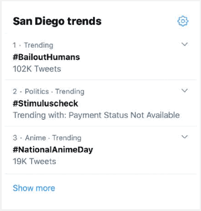How to stay on top of every trend in your contact centre (part 2) – In part 2 of his article series, Tim Harbers, CTO at Contexta360 looks at term trends. (See Part 1 Article)

Welcome to the second article on how to find and get value out of trends in speech analytics. Part one considered trends that involve metrics you can follow over time, such as call volume and agent performance.
 This article looks at terms that are popular, which is one of the most common ways to show an overall trend. See, for example, the way that Twitter displays trends:
This article looks at terms that are popular, which is one of the most common ways to show an overall trend. See, for example, the way that Twitter displays trends:
Wikipedia defines a trend as “a collective behaviour that lasts a short time”. So a trend is always connected to a certain time period, usually the one that is most recent. “Short time” is always a relative term, and it can range from looking at the past few years (macro trends) or much shorter trends such as the past 15 minutes (micro trends).
To find trending terms, the system evaluates the occurrence of each term and compares it with different periods of time. For example, the past hour is compared with the whole of last month. If the increase in occurrence of the term in the recent past is significantly higher than on an average day, the term is considered to be trending. Making a comparison is important in deciding if a term is part of a trend or not. Just using the most frequent terms from recent conversations will not work, because these terms may always occur frequently. That doesn’t make them trends.
There is also an important difference between relative increase in percentage and absolute increase. Consider the following example. The word outage is used on average in 1 per cent of each conversation. However, last week this percentage went up to 4 per cent. On the other hand, the word payment is normally used in 30 per cent of the conversations and this increased to 35 per cent last week. Which of the two words count as a trend? Even though payment has increased more in absolute difference (5 per cent vs 3 per cent), the increase in the word outage is much more significant in relative terms (4 times vs 1.17 times), assuming there are enough conversations to make even small percentage differences statistically significant.
On the other hand, you don’t want to see too many trending terms that rarely occur, even if the increase is interesting. This is especially true when your dataset size is relatively small. So the best algorithms for finding trending topics are always a trade-off between frequency and difference in frequency. One example is to calculate the z-score (or standard score) for each. term:
z-score = ([current trend] – [average historic trends]) / [standard deviation of historic trends]
When a z-score is used, the higher or lower the z-score the more abnormal the trend. When the z-score is highly positive then the trend is abnormally rising, while if it is highly negative it is abnormally falling. The z-score is also used in the calculation of TF-IDF, which is typically used by recommender systems.
 Trends can be visualised as a list of terms, like in Twitter, or can be displayed as a word cloud. The latter approach gives the user an instant visual indication of the frequency of the term, as the font sizes reflect this.
Trends can be visualised as a list of terms, like in Twitter, or can be displayed as a word cloud. The latter approach gives the user an instant visual indication of the frequency of the term, as the font sizes reflect this.
In addition, words could have different colours, for example, to indicate their type.
Word clouds can be used in several analyses, depending on the use case. The use cases can include:
» Recent trending terms
» Agent trending terms
» Topic trending terms
» Metric trending terms.
» Part of conversation trending terms
Recent trending terms
Recent trending terms are most relevant for call centre managers. A live dashboard for team managers can show word clouds from the past 15 minutes, the past hour and the past day. This means quick action can be taken whenever something happens.
Agent trending terms
Rather than comparing trend frequencies over time, it can be an interesting exercise to compare term frequencies of a single agent with the term frequencies of their entire team. This can offer insights into the agent’s performance and their typical way of speaking.
By knowing which words are used more frequently than the average, QM managers and agent coaches can get better insights and give more personalised coaching advice. Not every agent-specific trending term will be very interesting, for example the name of the agent will almost certainly be trending this way. Other words, however, can give indications on where the agent can improve, for example words connected to empathy and words that can indicate that the agent is not so sure of themselves.
Topic trending terms
Trending terms can also be used in relation to topics. For each topic, term frequency is compared with the average. This means a word cloud can be generated with the most correlating terms. Topic trending terms can be put into a few categories:
Terms that are (synonyms of) the topic itself
These are the most straightforward ones and also the least interesting.
Terms that describe causes and effects of the topic
These terms have a clear correlation with the topic. For example, if the topic is “internet connection problems”, these would be words such as Wi-Fi, modem, cable, and so on. Usually the words are self-explanatory, although it may give the user more insights into the main causes and side effects of a certain problem.
Words that describe the sentiment of a certain topic
Some topics are more sensitive than others and sometimes a topic almost always leads to an angry customer. If that is the case, then the topic word cloud will include emotion-related terms (for example: terrible, disappointed, great or happy). This gives the business analyst a quick indication of how the user feels about each individual topic.
Other terms
Sometimes you will discover topic-trending terms that you didn’t expect to see. Still, these terms can correlate with the topic in a significant way. Being able to zoom in and drill down on these terms helps you to get more context and to explain why they are correlating. Hopefully you have uncovered new and interesting subtopics!
Metric trending terms
Agent scorecards have multiple metrics on which to score the agent. Comparing terms used in high-performing interactions with those underperforming interactions can also sometimes generate interesting terms.
One example is to check for interesting terms in conversations with high silence. Those trending terms could potentially give insights into the causes of these silences. Finding terms related to conversations with low sentiment might give you insights into the potential reasons why customers have low sentiment. And viewing word clouds related to First Call Resolution can give you valuable insights into which business processes still need to be improved.
Filtering on parts of the conversation
It is not necessary only to analyse trending terms in the conversation as a whole. You can also focus on the parts of the conversation that interest you the most. The two most common conversation filters are speaker-based filtering and timing.
Conclusion
Finding interesting trends does not have to be limited to looking at line charts the whole time. By detecting trending terms from a relevant dataset (topic, metric, agents) and a reference set you can unlock a lot of value for all areas of your business.
 Tim Harber is CTOP at Contexta360
Tim Harber is CTOP at Contexta360



